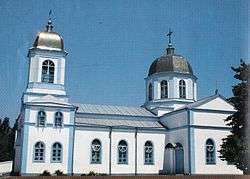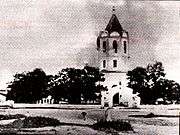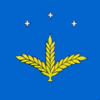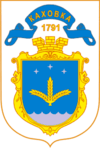Kakhovka
| Kakhovka Каховка | |||
|---|---|---|---|
 A church in Kakhovka | |||
| |||
 Map of Ukraine with Kakhovka highlighted. | |||
| Coordinates: 46°48′N 33°28′E / 46.800°N 33.467°ECoordinates: 46°48′N 33°28′E / 46.800°N 33.467°E | |||
| Country Oblast Raion |
Kherson Oblast Kakhovka Raion | ||
| Founded | 1791 | ||
| Population (2015) | |||
| • Total | 36,944 | ||
| Postal code | 74800 | ||
| Area code(s) | +380 5536 | ||
| Climate | Dfa | ||
| Website | http://www.kakhovka.ks.ua | ||
Kakhovka (Ukrainian: Каховка, Russian: Кахо́вка) is a port city on the Dnieper River in Kherson Oblast (province) of southern Ukraine. Serving as the administrative center of Kakhovka Raion (district), it is administratively incorporated as a city of oblast significance and does not belong to the raion. Population: 36,944 (2015 est.)[1]
It is home to the KZEZO (Electro-Welding Equipment Plant) as well as the Tavria Games festival.
There is a Swedish consulate in Kakhovka.
History
![]()
![]()
![]()
![]()
![]()
In 1492 Meñli I Giray established a fortress near the site of today's Kakhovka called İslâm Kermen (later also called Shagin-Girei, presumably after Şahin Giray). It was frequently attacked by Cossacks and was finally destroyed by them under the leadership of Ivan Mazepa in 1695. In 1791 the Russian Colonel D.M. Kulikovsky founded the trade town of Kakhovka. Kakhovka was situated in the Tauria district. In 1848 the town obtained city rights. In the 1870s–90s the town was renowned for having a huge population of low-income contractors (batraki). By a Russian economist (N.J. Tjezjakov) time-by-time 20-40.000 contractor gathered in the city, 80% of them males.

In December 1918, by the decision of the administration of the Dnipro povit (uyezd), Kakhovka was declared a city. In August 1920, during the final push in the Russian Civil War to drive the Whites under Wrangel out of the Crimea, Ieronim Uborevich established a bridgehead at Kakhovka, which became the site of fierce battles, "probably the closest the Civil War came to world war trench fighting."[2]
During World War II, Kakhovka was captured by the German Army on August 30, 1941. It was released by the 4th Ukrainian Front during the Melitopol offensive on November 2, 1943.
In 1972 the Verkhovna Rada of the Ukrainian SSR gave the city the rank of "city of oblast subordinance" within Kherson Oblast.
Cultural influence
The 1935 film Three Friends (Три товарища) included the song "Kakhovka" (words by Mikhail Svetlov and music by Isaak Dunayevsky), which became very well known, especially the refrain "Мы мирные люди, но наш бронепоезд/ Стоит на запасном пути" ("We are peaceful people, but our armored train/ Stands [ready] on the siding"). Svetlov chose the site of the little-known Civil War battle for his song because he had grown up nearby and had known the town during the war.[3]
The British-Ukrainian food writer, Olia Hercules grew up in Kakhovka.[4]
References
- ↑ "Чисельність наявного населення України (Actual population of Ukraine)" (PDF) (in Ukrainian). State Statistics Service of Ukraine. Retrieved 1 July 2016.
- ↑ Evan Mawdsley, The Russian Civil War (Edinburgh: Birlinn, 2008), p. 268.
- ↑ "Песня о Каховке".
- ↑ Fox, Killian (28 December 2014). "Rising stars of 2015: chef Olia Hercules". The Guardian. Retrieved 15 December 2016.
External links
- The murder of the Jews of Kakhovka during World War II, at Yad Vashem website.

